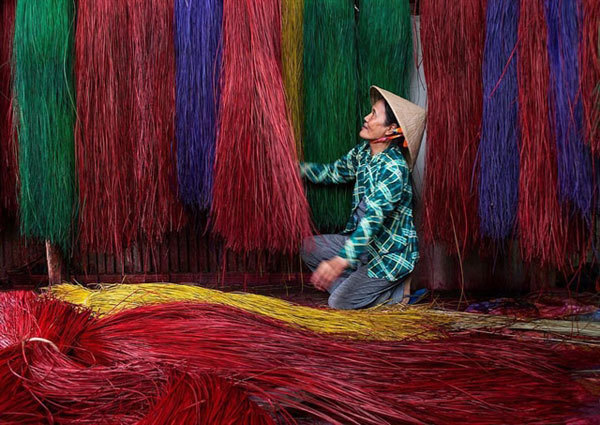 |
| Colours in Dinh Yen mat village. — Photo thamhiemmekong.com |
After more than 100 years of development, transcending time, space and market competition, the village has continued to make mats for domestic use and export, and was recognized as a National Intangible Cultural Heritage in 2013.
Although rustic, the patterned sedge mats have an ethereal and attractive beauty.
Now as the coronavirus pandemic has spread across the country, Dinh Yen has been affected, with the market for the mats stagnant. However, locals are still trying to maintain a moderate production of their traditional craft.
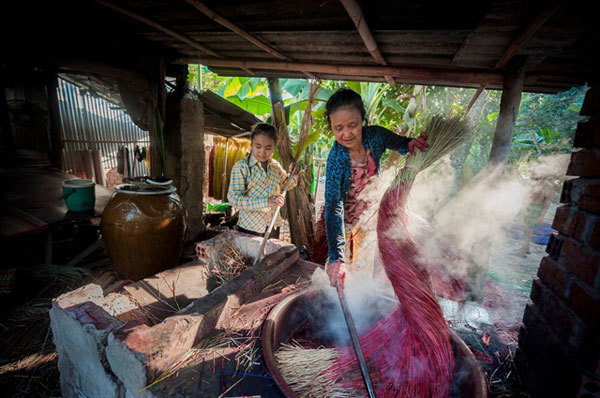 |
| Dyeing sedge threads in Dinh Yen mat village. — Photo thamhiemmekong.com |
Origins
When this land was still nothing but wild jungle, the first inhabitants here soon worked out how to take advantage of the wild sedge to weave bed mats for use in their daily lives. Slowly but surely the mats became indispensable and are today even used in a range of regional cultural ceremonies.
According to the village elders, in the past, their ancestors migrated from the northern coastal plain (Thai Binh and Nam Dinh provinces) to the south to settle, bringing the traditional craft with them to Dinh Yen
The warm southern climate and the many alluvial flats along the river near the village are favourable for sedge to grow, so the weaving trade thrived.
The craft was passed down among generations, and now the area is famous for its mats, which are supplied throughout the southern provinces.
No one remembers exactly when the village of Dinh Yen was founded, but in 1910, during what were prosperous times, a communal house was built here and the mat weaving went from strength to strength.
Currently, around 70 per cent of households in Dinh Yen work in mat weaving, and the village produces around 1 million pieces per year, with many exported to neighbouring Cambodia and Thailand.
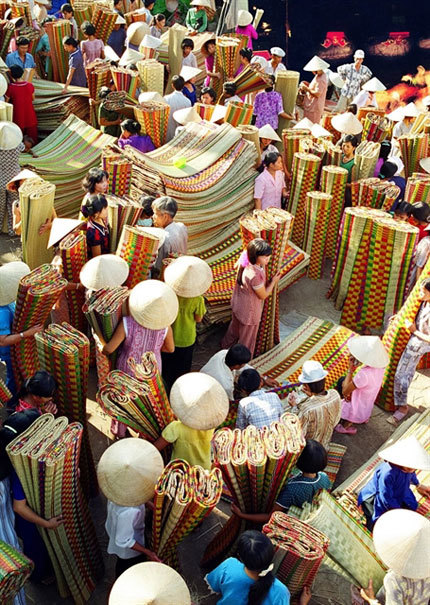 |
| A rural market selling Dinh Yen mats in busier times. — Photo thamhiemmekong.com |
Economic benefits
Dinh Yen mats are of outstanding quality with many different designs, sizes and colours, which can be customized at request.
A plain white mat costs from VND70,000-80,000 (US$3 -3.50), while a colour or flower-printed one is more expensive. Local mat weavers can earn around VND170,000 a day.
According to Nguyen Van Nen of An Loi A Village, in the 2000s the mat village fell into a period of decline due to competition from modern and luxurious bamboo mats, as well as those made from wood and plastic.
However, the unique qualities of the sedge mats combined with advantages in technology meant many households stuck with the craft and began to invest in weaving machines to shorten the time needed to make the mats while ensuring the quality met the new demands of the market.
Since then, sedge mats have no longer been viewed as simple country items, but have become a traditional product indicative of southern culture, a unique imprint of Dinh Yen craftsmen.
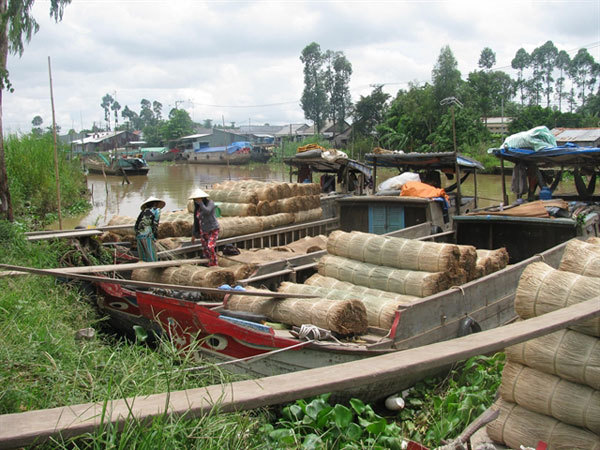 |
| People buy and sell sedge fibres to make mats. — Photo thamhiemmekong.com |
A local weaver said that each weaving machine costs around VND25 million. Within half a year, it is possible to recover the investment capital. She weaves 10-15 mats a day. Minus costs, she has a daily income of VND150,000-200,000
However, handmade mats possess qualities that machine-woven products cannot replace, and traditional woven mats still sell out. They are particularly popular among those seeking something unique.
Through their skillful hands, industriousness and love of the craft of their forefathers, every year, the local households produce vast numbers of patterned mats that are vibrant, smooth and durable.
Pham Thi Y of An Khuong Village says that every day she and her children can weave four to six mats by hand.
“Weaving by hand is hard, but it is still possible to do it because there are many people who prefer artisanal products to machine-made ones,” Y said.
According to a long-time artisan in An Binh Village, in order to weave a mat, the weaver has to choose sedge threads that are neither too big nor too soft. Once chosen, the sedge threads are then dyed.
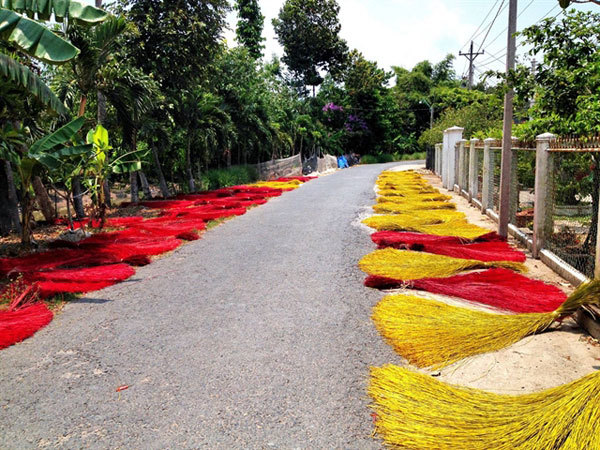 |
| Sedge threads are dried on most roads in Dinh Yen. — Photo thamhiemmekong.com |
After the dyeing is finished, the sedge must be dried in the sun for one to three hours before the weaving can begin.
Dinh Yen mats are a registered trademark with a detailed packaging and production process. They are sold in many supermarkets and shops nationwide.
According to Nguyen Van Sang, vice chairman of Dinh Yen Commune’s People's Committee, the mats sell very well and are exported to foreign countries, so people are excited to make them. However, since the outbreak of the pandemic, business has been badly affected.
“Once the city has the disease well under control, Dinh Yen mats are expected to develop more. We will propose for the district and province authorities to have policies to support the craft village in these difficult times,” said Sang.
“At the same time, we encourage some households to keep on weaving by hand in order to retain this ancient craft.”
Source: Vietnam News

Famous sites in Dong Thap province
Dong Thap province is in Vietnam’s southern Mekong Delta region. Its many natural scenic spots and historical and cultural sites make Dong Thap province an attractive tourist destination.

Youngsters make videos to honour beauty of Vietnamese women and traditional craft villages
Youngsters have displayed their creativeness in making videos to outline the Vietnamese cultural values and the beauty of Vietnamese women in traditional craft villages across the nation.